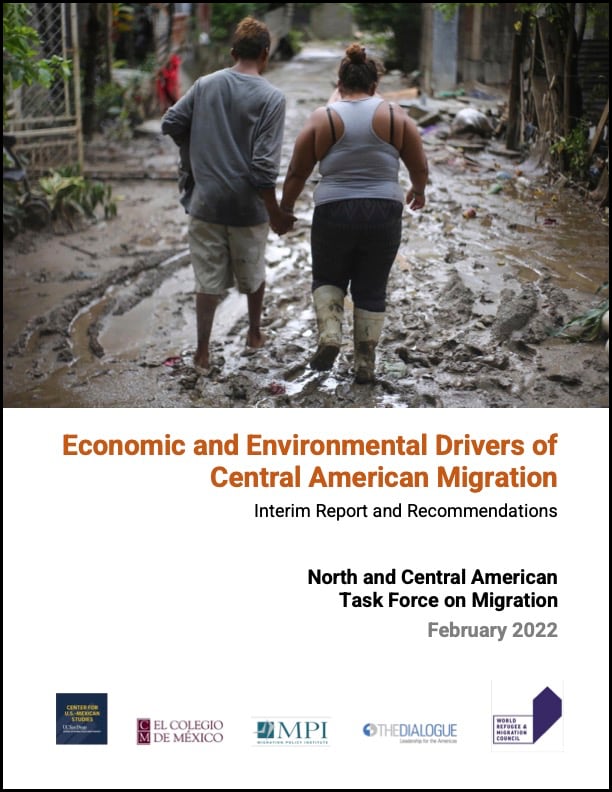Interim Report and Recommendations — North and Central American Task Force on Migration

Most Central American migrants cite economic conditions as a reason for their decision to leave their countries. For some it is the only reason: they migrate because they can no longer survive where they are. For some, their loss of livelihoods is due to environmental pressures such as drought, hurricanes or the long-term effects of climate change. For others, their decisions to migrate are the result of both economic desperation and personal insecurity due to criminal violence. For almost all of them, poverty and loss of hope that conditions will improve are factors in their decisions to move. Until that economic reality and those perceptions change, Central Americans will continue to seek economic opportunities in other countries. The fact is that for many Central Americans, migration is a tried-and-true poverty-reduction strategy. Working in the US or Canada not only improves their standards of living, but also supports their families’ survival back home through remittances. Until Central Americans perceive that they and their families can achieve a decent standard of living in their own countries, they will continue to move — even when militarized borders increase the risk and cost of migrating. While it is evident that the economic conditions driving Central American migration need to be improved, we insist that it is equally important – perhaps even more important – to tackle the political and institutional factors that have contributed to the region’s poverty, inequality and lack of economic opportunities. These economic inequities did not happen by chance; they are the result of political and institutional factors, such as widespread corruption and tax evasion, political decisions that short-change social protection, weaknesses in rule of law, regressive and low taxation systems and environmentally predatory economic practices. Increased foreign assistance without corresponding political reforms is unlikely to reduce migration. The Task Force’s report on political and institutional factors driving migration offers some recommendations for addressing those factors.
This report details some of the economic and environmental conditions that are driving migration. Many of these conditions are structural in nature and will require long-term investments. But there are measures that can be taken now which we believe will improve the lives of Central Americans and which could, incrementally at least, contribute to a reduction in the economic conditions that have led millions to make the dangerous trek northwards. This report focuses on those economic and environmental factors most closely linked to migration — strengthening employment opportunities in the formal sector; financial education, bankability, and access to credit; as well as education and opportunities for youth.Central American migration, however, is not only about Central Americans traveling to the US. Central American countries are migrant-sending countries but also are countries of transit and destination; there is considerable and regular back-and-forth movement across borders in the region. The three countries in Northern Central America also confront the great challenge of re-incorporating a significant number of their citizens returning from the US and Mexico, some voluntarily but principally through deportations. To complicate things even further, nationals from countries outside Central America are traveling through Central America towards the United States, including large numbers of Haitians.
This report is drawn from papers prepared by Carlos Alvarado, Instituto Centroamericano de Estudios Fiscales (Guatemala) — Estado de derecho en Centroamérica: consideraciones económicas y fiscales de la migración forzada; Manuel Orozco, Creative Associates (US) — Migrant Remittances to Central America and Options for Development; Pablo Escribano (IOM-Central America) — Environmental Drivers of Migration from Northern Central America; and Jaime Ordoñez (Faculty of Law, University of Costa Rica) — La pobreza como causa esencial de la expulsión humana y la migración (Centroamérica 2021-2022). The report also benefited from conversations with representatives of Partnership for Central America.
Le Groupe de travail sur la migration en Amérique du Nord et centrale is a non-governmental forum of academics, civil society and business leaders, and former policymakers in dialogue with current government officials created to facilitate a broadly driven solution dialogue among the countries involved in the crisis of migration and forced displacement in the region. Initiated by the World Refugee & Migration Council with the Center for U.S.-Mexican Studies, El Colegio de México, the Migration Policy Institute and the Inter-American Dialogue, the task force will issue concrete recommendations for collective, regional action based on evidentiary research to promote responsibility sharing across North and Central America.

